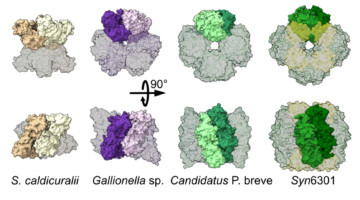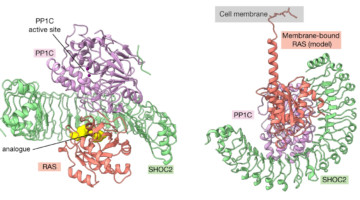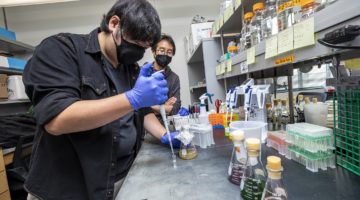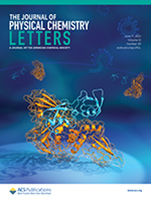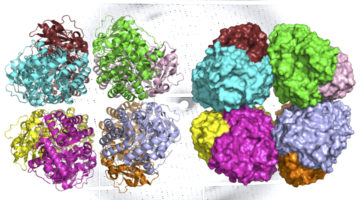With data obtained at the ALS, researchers gained insight into how an enzyme orchestrates the synthesis of a pectin polymer that imparts strength and flexibility to plant cell walls. The work could lead to improved biofuel production and guide the design of polymers with tailored functionalities for industrial or biomedical applications. Read more »![]()
![]()
Protein Assemblies Show Surprising Variability
Protein-structure studies performed in part at the ALS helped researchers discover that the protein assemblies in a key carbon-cycling enzyme can rearrange with surprising ease. The findings raise the prospect of genetically tuning the protein in agricultural plant species to produce more productive and resource-efficient crops. Read more »![]()
![]()
Structures Signal Fresh Targets for Anticancer Drugs
Researchers from Genentech used a suite of methods, including small-angle x-ray scattering, to learn how an assembly of three proteins works together to transmit signals for cell division. The work reveals new targets for the development of drugs that fight certain types of cancer, including lung, colorectal, and pancreatic cancer. Read more »![]()
![]()
Protein Structures Aren’t Set in Stone
A group of researchers studying the world’s most abundant protein, an enzyme involved in photosynthesis called rubisco, showed how evolution can lead to a surprising diversity of molecular assemblies that all accomplish the same task. The findings reveal the possibility that many of the proteins we thought we knew actually exist in other, unknown shapes. Read more »
Phosphomimetic S207D Lysyl–tRNA Synthetase Binds HIV-1 5′UTR in an Open Conformation and Increases RNA Dynamics
Binding assays, RNA chemical probing, and SAXS showed that phosphomimetic S207D LysRS binds in an open conformation preferentially to dimeric HIV-1 genomic RNA. A new working model is proposed wherein a dimeric phosphorylated LysRS/tRNA complex binds to a genomic RNA dimer, facilitating tRNA primer release and placement onto the binding site. Future anti-viral strategies that prevent this interaction are envisioned. Read more »
Assembly of the SARS-CoV-2 Replication Mechanism
Using a multimodal approach that included x-ray scattering at the ALS, researchers determined how components of the SARS-CoV-2 replication mechanism fit together. A better understanding of how this protein complex works provides insight into potential structural or functional weak spots to exploit for drug development. Read more »![]()
![]()
Deconstructing the Infectious Machinery of the SARS-CoV-2 Virus
Scientists collaborated to model the complex protein responsible for SARS-CoV-2 replication, revealing its potential weak spots for drug development. The investigation hinged on data collected from many advanced imaging techniques, including small-angle x-ray scattering (SAXS), crystallography, and small-angle neutron scattering (SANS). Read more »
Conformational Dynamics in the Interaction of SARS-CoV-2 Papain-like Protease with Human Interferon-Stimulated Gene 15 Protein
The image depicts the complex formed between SARS-CoV-2 papain-like protease and human interferon-stimulated gene 15 protein. Small-angle scattering elucidated the structural details of this complex providing insight into its role in suppressing the innate immune response and also potential routes for development of therapeutics to combat COVID-19. Read more »
How X-Rays Could Make Reliable, Rapid COVID-19 Tests a Reality
A highly sensitive lateral flow assay—the same type of device used in home pregnancy tests—could be developed using pairs of rigid antibodies that bind to the SARS-CoV-2 nucleocapsid protein. SAXS data showed that a particular pair of monoclonal antibodies bound to the nucleocapsid protein very strongly and stably, in part due to the antibodies’ rigidity. Read more »
Newly Discovered Photosynthesis Enzyme Yields Evolutionary Clues
Scientists have discovered a primitive form of rubisco, a photosynthesis enzyme that has helped shape life on Earth. Detailed information about its structure, determined using complementary techniques at the ALS, will help scientists understand how carbon-fixing organisms oxygenated the atmosphere and how modern plants evolved. Read more »

